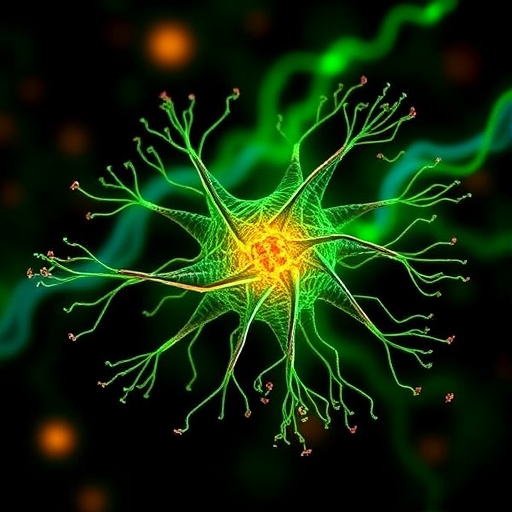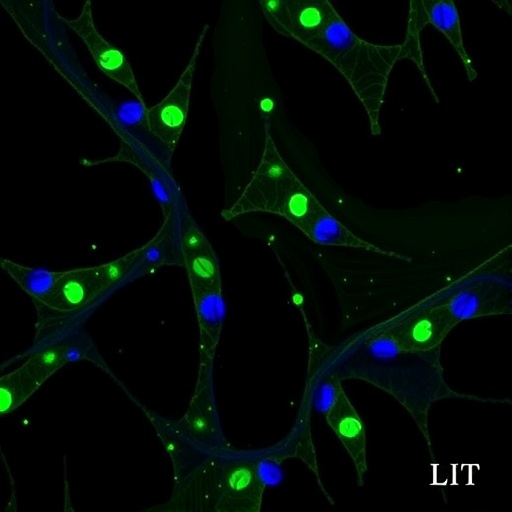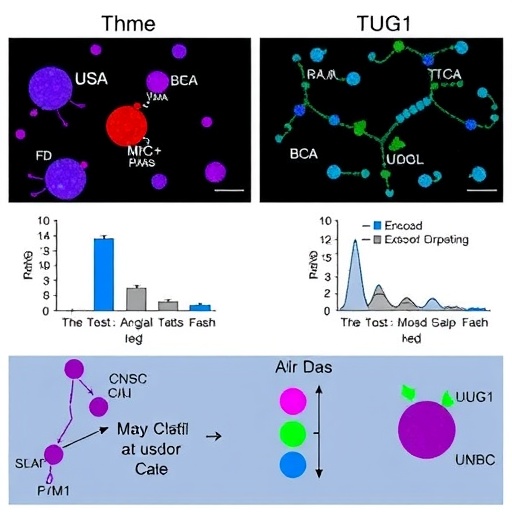In a groundbreaking study that could revolutionize the approach to leukemia treatment, researchers have uncovered the remarkable effects of natural compounds on modulating oxidative stress and programmed cell death pathways within leukemic cells. The investigation, conducted by Patergiannakis and colleagues, sheds new light on the therapeutic potential of harnessing the body’s intrinsic defense mechanisms, particularly through the activation of the nuclear factor erythroid 2–related factor 2 (Nrf2) pathway. This discovery opens promising avenues for non-toxic, nature-derived interventions in combating leukemia, a malignancy that has long challenged conventional treatment modalities.
Leukemia, particularly chronic myelogenous variants such as those represented by the K-562 cell line, presents a multifaceted challenge due to its complex pathophysiology involving disrupted cellular redox balance and evasion of apoptosis. The research team focused on the influence of natural Nrf2 activators—small molecules extracted from plants or other natural sources—known to orchestrate the cellular antioxidant response. By engaging Nrf2, cells bolster their defensive arsenal against reactive oxygen species (ROS), reducing oxidative stress, a critical player in cancer progression.
The nucleus of this study resides in understanding how these activators influence gene expression related to antioxidant enzymes and apoptotic regulators. Employing the K-562 leukemic cell line as a model, the researchers treated these cells with various natural compounds recognized for their Nrf2-activating properties. The results, visualized through a series of fluorescence assays and molecular analyses, demonstrate a significant upregulation of key antioxidant genes. This upregulation enhances the cells’ capacity to mitigate oxidative damage, which is often elevated in cancerous cells due to aberrant metabolism and inflammation.
.adsslot_TiKVCILfco{ width:728px !important; height:90px !important; }
@media (max-width:1199px) { .adsslot_TiKVCILfco{ width:468px !important; height:60px !important; } }
@media (max-width:767px) { .adsslot_TiKVCILfco{ width:320px !important; height:50px !important; } }
ADVERTISEMENT
However, the implications extend beyond mere antioxidant gene expression. The study reveals a dual role of Nrf2 activation, wherein these natural compounds not only elevate antioxidant defenses but concurrently induce apoptosis in leukemia cells. Apoptosis, or programmed cell death, represents a critical fail-safe against uncontrolled cellular proliferation. The balance between survival and death pathways is notoriously deregulated in cancer, and restoring this balance is a central objective in oncologic research.
The interplay between Nrf2 pathway activation and apoptosis presents intricate signaling crosstalk that the authors explore with meticulous detail. Upon Nrf2 activation by natural compounds, the downstream effect includes modulation of apoptotic markers such as caspases and Bcl-2 family proteins, which govern mitochondrial membrane integrity and cell survival decisions. This coordinated modulation promotes the elimination of the leukemic cells, suggesting that natural Nrf2 activators could serve as dual-function agents that nurture healthy antioxidant responses while selectively targeting malignant cells for death.
Technically, the research employs quantitative PCR, Western blotting, and flow cytometry to precisely map the molecular changes induced by treatment. These methodologies validate that natural compounds trigger significant transcriptional and translational changes consistent with enhanced antioxidant defense and pro-apoptotic signaling. The data implicates that therapeutic strategies enhancing Nrf2 activity could recalibrate redox homeostasis and sensitize leukemic cells to apoptosis, overcoming some resistance mechanisms encountered in traditional chemotherapy.
An intriguing aspect of the study lies in the differential expression profiles observed within the K-562 cells. The natural activators triggered a dose-dependent manner of gene expression changes, underscoring the importance of optimizing treatment regimens for maximal efficacy. This dose-responsiveness hints at the possibility of fine-tuning therapeutic windows to maximize benefits while minimizing potential side effects, a critical component in clinical translation.
Moreover, the researchers explore the molecular specificity of these natural activators, investigating whether their effects extend beyond Nrf2 to other related transcription factors or signaling pathways. Such specificity could contribute to the selectivity of apoptosis induction in leukemic cells while sparing healthy counterparts, addressing a perennial concern in cancer therapeutics regarding off-target toxicity.
Importantly, the study bridges a crucial gap between in vitro findings and potential clinical application. While the experiments are confined to cell culture models, the insights pave the way for in vivo investigations and ultimately clinical trials. Natural compounds that can safely activate Nrf2 and induce apoptosis without harming normal tissues stand as ideal candidates for adjuvant therapies in leukemia.
The broader implications extend to our understanding of oxidative stress in oncogenesis and its therapeutic modulation. The conventional view that antioxidants are universally beneficial is nuanced by cancer’s unique biochemistry, wherein a finely orchestrated increase and decrease of reactive species can either promote survival or trigger death. By strategically leveraging Nrf2 activators, this study highlights a sophisticated approach to tip this balance against cancer cells.
Furthermore, this research aligns with growing interest in integrative oncology, merging conventional treatments with natural compounds that possess pleiotropic effects on molecular pathways. The identification of specific, reliable natural Nrf2 activators could transform supportive care for leukemia patients, potentially improving outcomes and quality of life.
The authors also acknowledge limitations intrinsic to the study, such as the necessity of validating these findings in more complex systems and patients. Variability in human leukemia subtypes and the tumor microenvironment could influence responsiveness to Nrf2 activation. Nonetheless, these findings offer a robust foundation for future research aiming to exploit redox biology in cancer therapeutics.
In conclusion, the study by Patergiannakis and colleagues marks a significant stride in elucidating how natural Nrf2 activators can remarkably influence leukemic cells by modulating antioxidant gene expression and triggering apoptosis. This dual functionality underscores the therapeutic potential of these compounds, representing a hopeful frontier in leukemia treatment strategies. The meticulous molecular dissection adds to the accumulating evidence that targeting redox-sensitive transcription pathways can yield meaningful anticancer effects.
With cancer continuing to rank among the top causes of mortality worldwide, innovative approaches embracing nature’s pharmacopeia are not only timely but necessary. This research contributes a vital piece to the puzzle, suggesting that what we often find in nature’s own arsenal—in this case, natural Nrf2 activators—might hold keys to effective and less toxic cancer therapies.
As the community eagerly awaits subsequent phases of this research, the tantalizing prospect of safer, targeted leukemic treatments rooted in natural compounds grows ever stronger. The path forward will require interdisciplinary collaboration bridging molecular biology, pharmacology, and clinical research to translate these promising cellular findings into real-world medical breakthroughs for patients battling leukemia.
Subject of Research: Modulation of antioxidant gene expression and apoptosis in leukemic K-562 cells by natural Nrf2 activators
Article Title: Natural Nrf2 activators modulate antioxidant gene expression and apoptosis in leukemic K-562 cells
Article References:
Patergiannakis, IS., Georgiou-Siafis, S.K., Papadopoulou, L.C. et al. Natural Nrf2 activators modulate antioxidant gene expression and apoptosis in leukemic K-562 cells. Med Oncol 42, 396 (2025). https://doi.org/10.1007/s12032-025-02946-4
Image Credits: AI Generated
Tags: antioxidant gene expressionapoptosis regulation in leukemiacellular redox balancechronic myelogenous leukemia researchK-562 cell line studyleukemia treatment advancementsnatural compounds in cancer therapynatural Nrf2 activatorsnon-toxic cancer interventionsoxidative stress modulationprogrammed cell death pathwaystherapeutic potential of Nrf2





